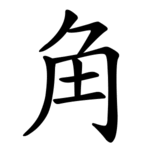Radical 148
Appearance
| 角 | ||
|---|---|---|
| ||
| 角 (U+89D2) "horn" | ||
| Pronunciations | ||
| Pinyin: | jiǎo | |
| Bopomofo: | ㄐㄧㄠˇ | |
| Wade–Giles: | chiao3 | |
| Cantonese Yale: | gok, luhk | |
| Jyutping: | gok3, luk6 | |
| Japanese Kana: | カク kaku (on'yomi) つの tsuno / かど kado (kun'yomi) | |
| Sino-Korean: | 각 gak | |
| Names | ||
| Japanese name(s): | 角/つの tsuno 角偏/つのへん/かくへん tsunohen/kakuhen | |
| Hangul: | 뿔 ppul | |
| Stroke order animation | ||
 | ||
Radical 148 or radical horn (角部) meaning "horn" is one of the 20 Kangxi radicals (214 radicals in total) composed of 7 strokes.
In the Kangxi Dictionary, there are 158 characters (out of 49,030) to be found under this radical.
角 is also the 165th indexing component in the Table of Indexing Chinese Character Components predominantly adopted by Simplified Chinese dictionaries published in mainland China.
Evolution
[edit]-
Oracle bone script character
-
Bronze script character
-
Large seal script character
-
Small seal script character
Derived characters
[edit]| Strokes | Characters |
|---|---|
| +0 | 角 |
| +2 | 觓 觔 (=斤 -> 斤 / 筋 -> 竹) |
| +4 | 觕 (=粗 -> 米) 觖 觗 觘 觙 |
| +5 | 觚 觛 觝 觞SC (=觴) |
| +6 | 觜 觟 觠 觡 觢 解 觤 觥 触SC/JP (=觸) 觧 (=解 / 鮮 -> 魚) |
| +7 | 觨 觩 觪 觫 |
| +8 | 觬 觭 觮 觯SC (=觶) |
| +9 | 觰 觱 |
| +10 | 觲 觳 |
| +11 | 觴 鵤 |
| +12 | 觵 觶 |
| +13 | 觷 觸 觹 |
| +14 | 觺 |
| +15 | 觻 觼 |
| +16 | 觽 觾 |
| +18 | 觿 |
Variant forms
[edit]This radical character has different forms and stroke orders in different languages.
-
Stroke order in Traditional Chinese
-
Stroke order in Japanese
-
Simplified Chinese xin zixing
Sinogram
[edit]The radical is also used as an independent Chinese character. It is one of the Kyōiku kanji or Kanji taught in elementary school in Japan.[1] It is a second grade kanji[1]
References
[edit]- ^ a b "The Kyoiku Kanji (教育漢字) - Kanshudo". www.kanshudo.com. Archived from the original on March 24, 2022. Retrieved 2023-05-06.
Literature
[edit]- Fazzioli, Edoardo (1987). Chinese calligraphy : from pictograph to ideogram : the history of 214 essential Chinese/Japanese characters. calligraphy by Rebecca Hon Ko. New York: Abbeville Press. ISBN 0-89659-774-1.
See also
[edit]Wikimedia Commons has media related to Radical 148.







